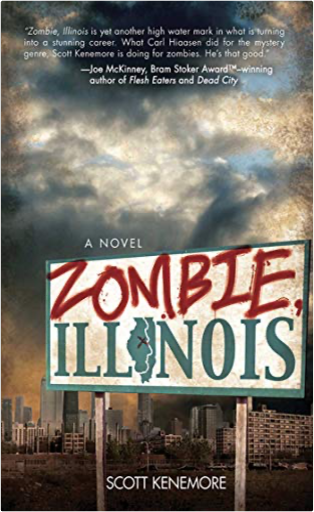 Zombie, Illinois: A NovelScott Kenemore Zombie, Illinois: A NovelScott Kenemore The sequel to the bestselling Zombie, Ohio, this explosive supernatural thriller from Scott Kenemore tells the story of three Chicagoans who have been thrown together by a bizarre, interconnected series of events during the first twenty-four hours of a zombie outbreak in the Midwest's largest city. A partnership is crafted between a pastor from Chicago's rough South Side, an intrepid newspaper reporter, and a young female musician, all of whom are fighting for survival as they struggle to protect themselves and their communities in a city overrun with the walking dead. Between the barricaded neighborhoods and violent zombie hunters, the trio encounters many mysterious occurrences that leave them shaken and disturbed. When the mayor of Chicago is eaten by zombies on live television, and a group of shady aldermen attempt to seize power in the vacuum, these unlikely friends realize that they have stumbled upon a conspiracy to overthrow the city . . . and that they alone may be qualified to combine their talents to stop it.
Zombie, Illinois will delight devoted zombie fans and put readers in mind of some of the best recent works of supernatural horror. You will be left shocked, horrified, and craving brains! This novel will grab you from the first page and not let go until the riveting finale. 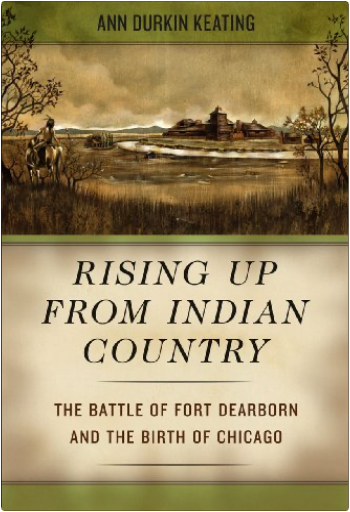 Rising Up from Indian Country: The Battle of Fort Dearborn and the Birth of ChicagoAnn Durkin Keating Rising Up from Indian Country: The Battle of Fort Dearborn and the Birth of ChicagoAnn Durkin Keating In August 1812, under threat from the Potawatomi, Captain Nathan Heald began the evacuation of ninety-four people from the isolated outpost of Fort Dearborn to Fort Wayne. The group included several dozen soldiers, as well as nine women and eighteen children. After traveling only a mile and a half, they were attacked by five hundred Potawatomi warriors. In under an hour, fifty-two members of Heald’s party were killed, and the rest were taken prisoner; the Potawatomi then burned Fort Dearborn before returning to their villages. These events are now seen as a foundational moment in Chicago’s storied past. With Rising up from Indian Country, noted historian Ann Durkin Keating richly recounts the Battle of Fort Dearborn while situating it within the context of several wider histories that span the nearly four decades between the 1795 Treaty of Greenville, in which Native Americans gave up a square mile at the mouth of the Chicago River, and the 1833 Treaty of Chicago, in which the American government and the Potawatomi exchanged five million acres of land west of the Mississippi River for a tract of the same size in northeast Illinois and southeast Wisconsin. In the first book devoted entirely to this crucial period, Keating tells a story not only of military conquest but of the lives of people on all sides of the conflict. She highlights such figures as Jean Baptiste Point de Sable and John Kinzie and demonstrates that early Chicago was a place of cross-cultural reliance among the French, the Americans, and the Native Americans. Published to commemorate the bicentennial of the Battle of Fort Dearborn, this gripping account of the birth of Chicago will become required reading for anyone seeking to understand the city and its complex origins. 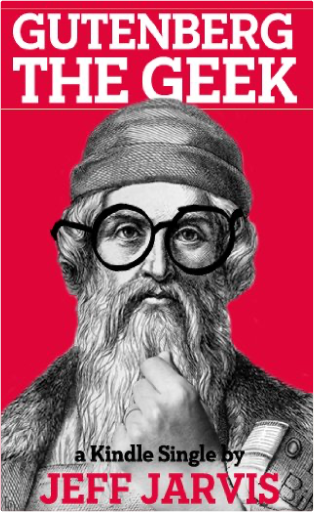 Gutenberg the GeekJeff Jarvis Gutenberg the GeekJeff Jarvis Johannes Gutenberg was our first geek, the original technology entrepreneur, who had to grapple with all the challenges a Silicon Valley startup faces today. Jeff Jarvis tells Gutenberg's story from an entrepreneurial perspective, examining how he overcame technology hurdles, how he operated with the secrecy of a Steve Jobs but then shifted to openness, how he raised capital and mitigated risk, and how, in the end, his cash flow and equity structure did him in. This is also the inspiring story of a great disruptor. That is what makes Gutenberg the patron saint of entrepreneurs.
Jeff Jarvis is the author of "Public Parts: How Sharing in the Digital Age Improves the Way We Work and Live" and "What Would Google Do?: Reverse-Engineering the Fastest Growing Company in the History of the World." He directs the Tow-Knight Center for Entrepreneurial Journalism at the City University of New York Graduate School of Journalism. 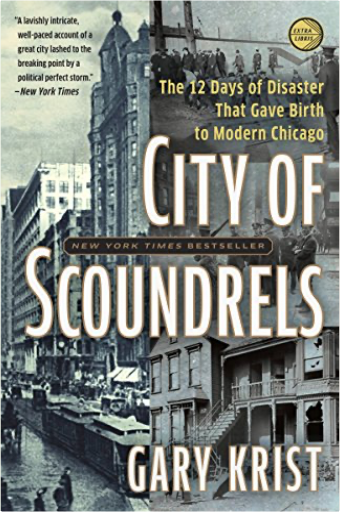 City of Scoundrels: The 12 Days of Disaster That Gave Birth to Modern ChicagoGary Krist City of Scoundrels: The 12 Days of Disaster That Gave Birth to Modern ChicagoGary Krist The masterfully told story of twelve volatile days in Chicago, when an aviation disaster, a race riot, a crippling transit strike, and a sensational child murder transfixed and roiled a city already on the brink of collapse.
When 1919 began, the city of Chicago seemed on the verge of transformation. Modernizers had an audacious, expensive plan to turn the city from a brawling, unglamorous place into "the Metropolis of the World." But just as the dream seemed within reach, pandemonium broke loose and the city's highest ambitions were suddenly under attack by the same unbridled energies that had given birth to them.
It began on a balmy Monday afternoon when a blimp in flames crashed through the roof of a busy downtown bank, incinerating those inside. Within days, a racial incident at a crowded South Side beach spiraled into one of the worst urban riots in American history, followed by a transit strike that paralyzed the city. Then, when it seemed as if things could get no worse, police searching for a six-year-old girl discovered her body in a dark North Side basement.
Meticulously researched and expertly paced, City of Scoundrels captures the tumultuous birth of the modern American city, with all of its light and dark aspects in vivid relief.
Now with Extra Libris material, including a reader’s guide and bonus content 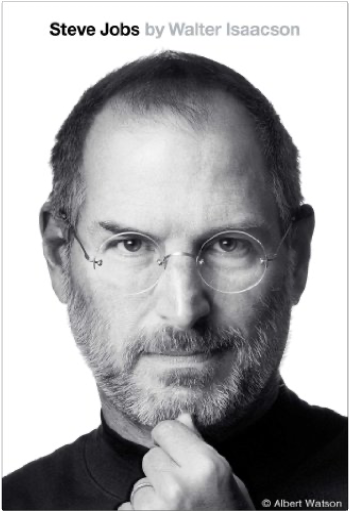 Steve JobsWalter Isaacson Steve JobsWalter Isaacson Based on more than forty interviews with Jobs conducted over two years—as well as interviews with more than a hundred family members, friends, adversaries, competitors, and colleagues—Walter Isaacson has written a riveting story of the roller-coaster life and searingly intense personality of a creative entrepreneur whose passion for perfection and ferocious drive revolutionized six industries: personal computers, animated movies, music, phones, tablet computing, and digital publishing.
At a time when America is seeking ways to sustain its innovative edge, and when societies around the world are trying to build digital-age economies, Jobs stands as the ultimate icon of inventiveness and applied imagination. He knew that the best way to create value in the twenty-first century was to connect creativity with technology. He built a company where leaps of the imagination were combined with remarkable feats of engineering.
Although Jobs cooperated with this book, he asked for no control over what was written nor even the right to read it before it was published. He put nothing off-limits. He encouraged the people he knew to speak honestly. And Jobs speaks candidly, sometimes brutally so, about the people he worked with and competed against. His friends, foes, and colleagues provide an unvarnished view of the passions, perfectionism, obsessions, artistry, devilry, and compulsion for control that shaped his approach to business and the innovative products that resulted.
Driven by demons, Jobs could drive those around him to fury and despair. But his personality and products were interrelated, just as Apple’s hardware and software tended to be, as if part of an integrated system. His tale is instructive and cautionary, filled with lessons about innovation, character, leadership, and values.  Reamde: A NovelNeal Stephenson Reamde: A NovelNeal Stephenson “Stephenson has a once-in-a-generation gift: he makes complex ideas clear, and he makes them funny, heartbreaking, and thrilling.”
—Time
The #1 New York Times bestselling author of Anathem, Neal Stephenson is continually rocking the literary world with his brazen and brilliant fictional creations—whether he’s reimagining the past (The Baroque Cycle), inventing the future (Snow Crash), or both (Cryptonomicon). With Reamde, this visionary author whose mind-stretching fiction has been enthusiastically compared to the work of Thomas Pynchon, Don DeLillo, Kurt Vonnegut, and David Foster Wallace—not to mention William Gibson and Michael Crichton—once again blazes new ground with a high-stakes thriller that will enthrall his loyal audience, science and science fiction, and espionage fiction fans equally. The breathtaking tale of a wealthy tech entrepreneur caught in the very real crossfire of his own online fantasy war game, Reamde is a new high—and a new world—for the remarkable Neal Stephenson.  The Zombie Survival Guide: Complete Protection from the Living DeadMax Brooks The Zombie Survival Guide: Complete Protection from the Living DeadMax Brooks The Zombie Survival Guide is your key to survival against the hordes of undead who may be stalking you right now. Fully illustrated and exhaustively comprehensive, this book covers everything you need to know, including how to understand zombie physiology and behavior, the most effective defense tactics and weaponry, ways to outfit your home for a long siege, and how to survive and adapt in any territory or terrain.
Top 10 Lessons for Surviving a Zombie Attack
1. Organize before they rise!
2. They feel no fear, why should you?
3. Use your head: cut off theirs.
4. Blades don’t need reloading.
5. Ideal protection = tight clothes, short hair.
6. Get up the staircase, then destroy it.
7. Get out of the car, get onto the bike.
8. Keep moving, keep low, keep quiet, keep alert!
9. No place is safe, only safer.
10. The zombie may be gone, but the threat lives on.
Don’t be carefree and foolish with your most precious asset—life. This book is your key to survival against the hordes of undead who may be stalking you right now without your even knowing it. The Zombie Survival Guide offers complete protection through trusted, proven tips for safeguarding yourself and your loved ones against the living dead. It is a book that can save your life. 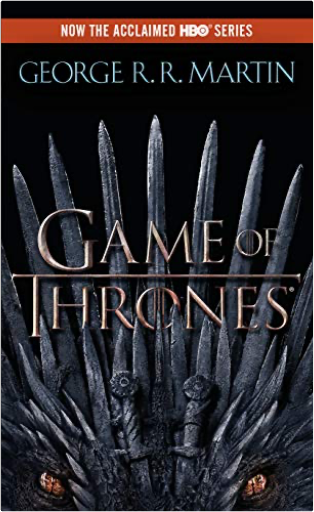 A Game of ThronesGeorge R. R. Martin A Game of ThronesGeorge R. R. Martin NOW THE ACCLAIMED HBO SERIES GAME OF THRONES—THE MASTERPIECE THAT BECAME A CULTURAL PHENOMENON
Winter is coming. Such is the stern motto of House Stark, the northernmost of the fiefdoms that owe allegiance to King Robert Baratheon in far-off King’s Landing. There Eddard Stark of Winterfell rules in Robert’s name. There his family dwells in peace and comfort: his proud wife, Catelyn; his sons Robb, Brandon, and Rickon; his daughters Sansa and Arya; and his bastard son, Jon Snow. Far to the north, behind the towering Wall, lie savage Wildings and worse—unnatural things relegated to myth during the centuries-long summer, but proving all too real and all too deadly in the turning of the season.
Yet a more immediate threat lurks to the south, where Jon Arryn, the Hand of the King, has died under mysterious circumstances. Now Robert is riding north to Winterfell, bringing his queen, the lovely but cold Cersei, his son, the cruel, vainglorious Prince Joffrey, and the queen’s brothers Jaime and Tyrion of the powerful and wealthy House Lannister—the first a swordsman without equal, the second a dwarf whose stunted stature belies a brilliant mind. All are heading for Winterfell and a fateful encounter that will change the course of kingdoms.
Meanwhile, across the Narrow Sea, Prince Viserys, heir of the fallen House Targaryen, which once ruled all of Westeros, schemes to reclaim the throne with an army of barbarian Dothraki—whose loyalty he will purchase in the only coin left to him: his beautiful yet innocent sister, Daenerys. 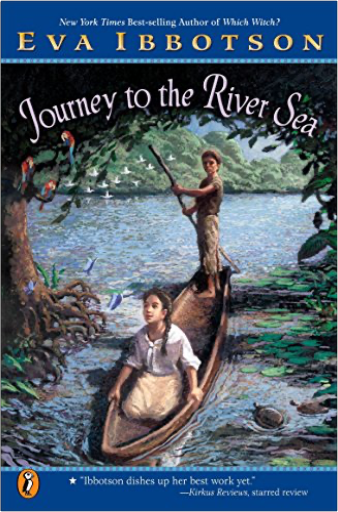 Journey to the River SeaEva Ibbotson Journey to the River SeaEva Ibbotson With the memorable characters and plot twists she brings to her best-selling fantasies, acclaimed author Eva Ibbotson has written a hair-raising novel, set in turn-of-the-last-century Brazil.
Accompanied by Miss Minton, a fierce-looking, no-nonsense governess, Maia, a young orphan, sets off for the wilderness of the Amazon, expecting curtains of orchids, brightly colored macaws, and a loving family. But what she finds is an evil-tempered aunt and uncle and their spoiled daughters. It is only when she is swept up in a mystery involving a young Indian boy, a homesick child actor, and a missing inheritance that Maia lands in the middle of the Amazon adventure she's dreamed of. Readers of every generation will treasure Ibbotson's lush historical adventure that harkens back to the beloved classics of Frances Hodgson Burnett and Louisa May Alcott. 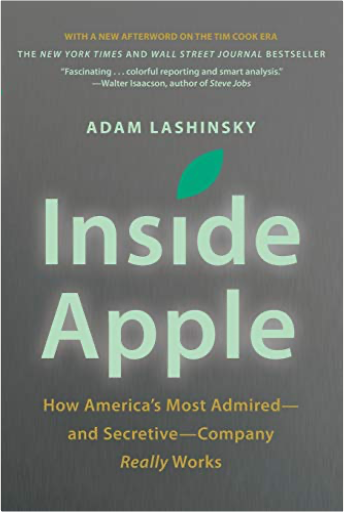 Inside Apple: How America's Most Admired - And Secretive - Company Really WorksAdam Lashinsky Inside Apple: How America's Most Admired - And Secretive - Company Really WorksAdam Lashinsky INSIDE APPLE reveals the secret systems, tactics and leadership strategies that allowed Steve Jobs and his company to churn out hit after hit and inspire a cult-like following for its products.
If Apple is Silicon Valley's answer to Willy Wonka's Chocolate Factory, then author Adam Lashinsky provides readers with a golden ticket to step inside. In this primer on leadership and innovation, the author will introduce readers to concepts like the "DRI" (Apple's practice of assigning a Directly Responsible Individual to every task) and the Top 100 (an annual ritual in which 100 up-and-coming executives are tapped a la Skull & Bones for a secret retreat with company founder Steve Jobs).
Based on numerous interviews, the book offers exclusive new information about how Apple innovates, deals with its suppliers and is handling the transition into the Post Jobs Era. Lashinsky, a Senior Editor at Large for Fortune, knows the subject cold: In a 2008 cover story for the magazine entitled The Genius Behind Steve: Could Operations Whiz Tim Cook Run The Company Someday he predicted that Tim Cook, then an unknown, would eventually succeed Steve Jobs as CEO.
While Inside Apple is ostensibly a deep dive into one, unique company (and its ecosystem of suppliers, investors, employees and competitors), the lessons about Jobs, leadership, product design and marketing are universal. They should appeal to anyone hoping to bring some of that Apple magic to their own company, career, or creative endeavor.  World War Z: An Oral History of the Zombie WarMax Brooks World War Z: An Oral History of the Zombie WarMax Brooks “The end was near.” —Voices from the Zombie War
The Zombie War came unthinkably close to eradicating humanity. Max Brooks, driven by the urgency of preserving the acid-etched first-hand experiences of the survivors from those apocalyptic years, traveled across the United States of America and throughout the world, from decimated cities that once teemed with upwards of thirty million souls to the most remote and inhospitable areas of the planet. He recorded the testimony of men, women, and sometimes children who came face-to-face with the living, or at least the undead, hell of that dreadful time. World War Z is the result. Never before have we had access to a document that so powerfully conveys the depth of fear and horror, and also the ineradicable spirit of resistance, that gripped human society through the plague years.
Ranging from the now infamous village of New Dachang in the United Federation of China, where the epidemiological trail began with the twelve-year-old Patient Zero, to the unnamed northern forests where untold numbers sought a terrible and temporary refuge in the cold, to the United States of Southern Africa, where the Redeker Plan provided hope for humanity at an unspeakable price, to the west-of-the-Rockies redoubt where the North American tide finally started to turn, this invaluable chronicle reflects the full scope and duration of the Zombie War.
Most of all, the book captures with haunting immediacy the human dimension of this epochal event. Facing the often raw and vivid nature of these personal accounts requires a degree of courage on the part of the reader, but the effort is invaluable because, as Mr. Brooks says in his introduction, “By excluding the human factor, aren’t we risking the kind of personal detachment from history that may, heaven forbid, lead us one day to repeat it? And in the end, isn’t the human factor the only true difference between us and the enemy we now refer to as ‘the living dead’?”
Note: Some of the numerical and factual material contained in this edition was previously published under the auspices of the United Nations Postwar Commission.
Eyewitness reports from the first truly global war
“I found ‘Patient Zero’ behind the locked door of an abandoned apartment across town. . . . His wrists and feet were bound with plastic packing twine. Although he’d rubbed off the skin around his bonds, there was no blood. There was also no blood on his other wounds. . . . He was writhing like an animal; a gag muffled his growls. At first the villagers tried to hold me back. They warned me not to touch him, that he was ‘cursed.’ I shrugged them off and reached for my mask and gloves. The boy’s skin was . . . cold and gray . . . I could find neither his heartbeat nor his pulse.” —Dr. Kwang Jingshu, Greater Chongqing, United Federation of China
“‘Shock and Awe’? Perfect name. . . . But what if the enemy can’t be shocked and awed? Not just won’t, but biologically can’t! That’s what happened that day outside New York City, that’s the failure that almost lost us the whole damn war. The fact that we couldn’t shock and awe Zack boomeranged right back in our faces and actually allowed Zack to shock and awe us! They’re not afraid! No matter what we do, no matter how many we kill, they will never, ever be afraid!” —Todd Wainio, former U.S. Army infantryman and veteran of the Battle of Yonkers
“Two hundred million zombies. Who can even visualize that type of number, let alone combat it? . . . For the first time in history, we faced an enemy that was actively waging total war. They had no limits of endurance. They would never negotiate, never surrender. They would fight until the very end because, unlike us, every single one of them, every second of every day, was devoted to consuming all life on Earth.” —General Travis D’Ambrosia, Supreme Allied Commander, Europe 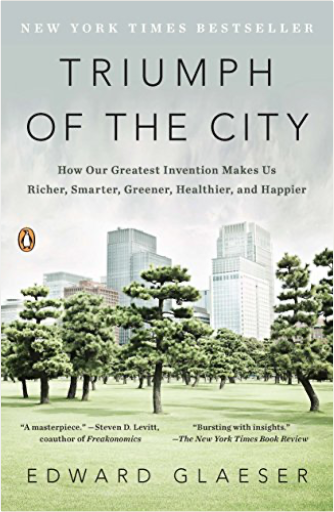 Triumph of the City: How Our Greatest Invention Makes Us Richer, Smarter, Greener, Healthier, and HappierEdward Glaeser Triumph of the City: How Our Greatest Invention Makes Us Richer, Smarter, Greener, Healthier, and HappierEdward Glaeser A pioneering urban economist presents a myth-shattering look at the majesty and greatness of cities
America is an urban nation, yet cities get a bad rap: they're dirty, poor, unhealthy, environmentally unfriendly . . . or are they? In this revelatory book, Edward Glaeser, a leading urban economist, declares that cities are actually the healthiest, greenest, and richest (in both cultural and economic terms) places to live. He travels through history and around the globe to reveal the hidden workings of cities and how they bring out the best in humankind. Using intrepid reportage, keen analysis, and cogent argument, Glaeser makes an urgent, eloquent case for the city's importance and splendor, offering inspiring proof that the city is humanity's greatest creation and our best hope for the future.
"A masterpiece."—Steven D. Levitt, coauthor of Freakonomics
"Bursting with insights."—The New York Times Book Review |
 Zombie, Illinois: A NovelScott Kenemore
Zombie, Illinois: A NovelScott Kenemore  Rising Up from Indian Country: The Battle of Fort Dearborn and the Birth of ChicagoAnn Durkin Keating
Rising Up from Indian Country: The Battle of Fort Dearborn and the Birth of ChicagoAnn Durkin Keating  Gutenberg the GeekJeff Jarvis
Gutenberg the GeekJeff Jarvis  City of Scoundrels: The 12 Days of Disaster That Gave Birth to Modern ChicagoGary Krist
City of Scoundrels: The 12 Days of Disaster That Gave Birth to Modern ChicagoGary Krist  Steve JobsWalter Isaacson
Steve JobsWalter Isaacson  Reamde: A NovelNeal Stephenson
Reamde: A NovelNeal Stephenson  The Zombie Survival Guide: Complete Protection from the Living DeadMax Brooks
The Zombie Survival Guide: Complete Protection from the Living DeadMax Brooks  A Game of ThronesGeorge R. R. Martin
A Game of ThronesGeorge R. R. Martin  Journey to the River SeaEva Ibbotson
Journey to the River SeaEva Ibbotson  Inside Apple: How America's Most Admired - And Secretive - Company Really WorksAdam Lashinsky
Inside Apple: How America's Most Admired - And Secretive - Company Really WorksAdam Lashinsky  World War Z: An Oral History of the Zombie WarMax Brooks
World War Z: An Oral History of the Zombie WarMax Brooks  Triumph of the City: How Our Greatest Invention Makes Us Richer, Smarter, Greener, Healthier, and HappierEdward Glaeser
Triumph of the City: How Our Greatest Invention Makes Us Richer, Smarter, Greener, Healthier, and HappierEdward Glaeser  Made with Delicious Library
Made with Delicious Library